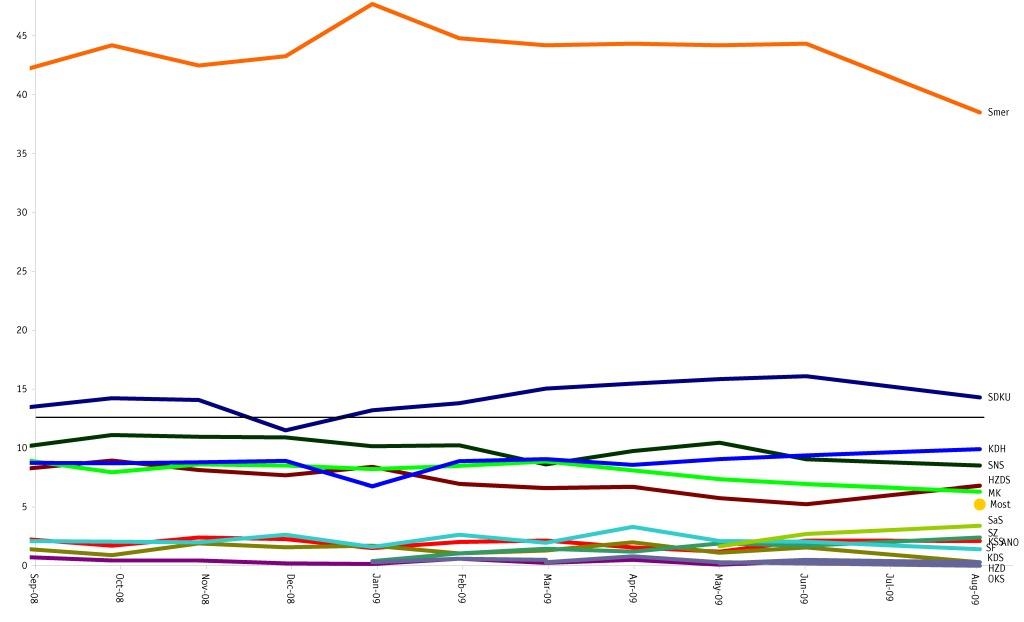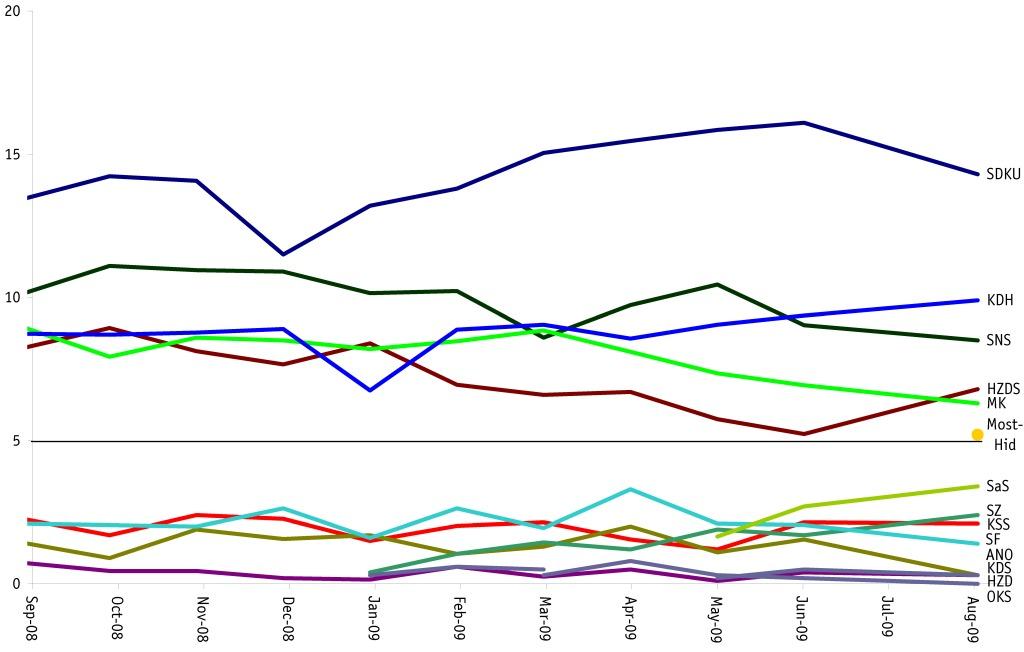No time to do a thorough post right now but a Polis came out yesterday and FOCUS came out today. Click the Dashboard above for the graphs. Here are few thoughts:
- Smer. Both polls show the party slightly down but not by much. The party has averaged between 38 and 41 for the last 6 months. It is now on the low side of that but there are no signs of either a precipitous drop or a recovery. Of course it will all depend on the likelihood of the “soft” Smer voters (of whom there are probably quite many) to go and vote.
- SNS. Polis shows a further drop to just above the threshold (but Polis has usually polled low for SNS compared to the others). FOCUS shows it holding steady around 6%. It probably does hang just above the threshold and its future may depend on an unlikely combination of Orban and Meciar. We all know Orban is going to win but the tone of the campaign could help SNS a bit; if Meciar begins to fall repeatedly below the threshold, some voters might also shift to the next nearest “national” party, which is SNS. There is still some degree of reciprocity between the voters of these parties, as with KDH and SDKU.

- HZDS. Polis again shows it below the threshold, but Polis has usually polled low for HZDS. FOCUS shows it with 5.2, the firm’s lowest result for the party since summer of last year. Together these produce an average of 4.9 and so HZDS does not appear on this month’s roster of parliamentary parties. Of course the upcoming Median survey will put the HZDS average back above the threshold, so there will not appear to be much of a change, but HZDS is clearly on the brink, and a drop like that of summer 2009 (and from a lower starting point) could knock the party out, especially if the April and May polls show it low and a few voters start to balk.
- SDKU. Polis shows a drop from a high point; FOCUS shows a rise from a low point. It is somewhere between 13% and 15%. FOCUS, in particular, has shown a yo-yo, alternating between over 14 and under 12 since Fall. Of course SDKU has been a bit of a yo-yo, with scandal followed by recovery. Next month will help show whether the recovery shown by FOCUS is a “Radicova” bonus or just noise.
- KDH. In typical fashion the headline writer at the paper SME trumpeted KDH surpassing SDKU (along with a picture of Dzurinda pulling out a chair for Figel–they have pictures of elites interacting that serve every possible combination of events), but of course it probably doesn’t mean anything. Polis puts KDH at a record high (and SDKU a bit low). FOCUS puts KDH slightly higher. Since FOCUS tends to poll slightly low for KDH and Polis tends to poll slightly high, the story–not one worthy of headlines–is KDH slightly up.
- SaS. Very little SaS news this month but that in itself is news: FOCUS and Polis both show the party slightly down from last month, suggesting that Feburary may have been its peak. A pre-election peak is a natural near-inevitability and is assisted by the election of Radicova to head the SDKU campaign during this period. Watch what happens next here. From the party’s position, the good news is that its peak and the resulting visibility is fairly high, permitting the party to sustain some losses.
- Most-Hid and MKP-SMK. Both FOCUS and Polis show both parties slightly up, which seems unlikely in reality but which may be noise or a reaction to Hungarian-Slovak disputes. In any case, MKP-SMK stands rather close to the threshold–too close for its comfort, I’m sure–but holds the organizational base, while Most-Hid stands higher but with a weaker voting base. Either (but probably not both) could fall below the threshold… which brings me to a final thought.
The Importance of Thresholds.
As is to be expected these days, the Pravda headline writer announced yesterday, “Yet another poll shows opposition victory; HZDS remains below the line.” And that is correct, as far as it goes. The problem is “yet another” in this case means “yet another from the same polling firm” which is less surprising and that this firm has traditionally polled low for HZDS. This is not to say that HZDS is not in trouble, but the lack of analysis is, as usual, unfortunate. The really interesting point here–one which I do not blame newspaper writers for covering just yet–is that many parties are near the threshold and a .1% difference may shape Slovakia’s next government. This month is an example. The opposition and coalition are balanced closely enough that if one party from either side falls below (and there are two parties on each side near the line), it could mean victory for the other. In the Polis poll dramatized by Pravda, it is HZDS that has fallen below, meaning that its seats get redistributed and Smer loses a partner, pushing it narrowly below the line. Were HZDS 0.6% higher (7 more respondents in the poll), HZDS would stay above the threshold and the current coalition remains intact. Such a small difference is not detectable by polls (even if we could get a perfectly representative sample and perfectly predict turnout behavior, it is still well within the margin of error).
It is also worth noting that an equally slight difference in SMK would put that party below the threshold and make it impossible for an “opposition” government, even if HZDS also fell below.
I hope to post more on threshold math in the near future. Some preliminary calculations appear near the end of the Slovak Politics in a Nutshell post.

















 I know Slovakia’s journalists are overtaxed with all that is required of them, but there are things they could do to make things better without too much extra work. Case in point: today all major Slovak news sources today report, almost word for word, a press release from the firm Median reporting poll results from July:
I know Slovakia’s journalists are overtaxed with all that is required of them, but there are things they could do to make things better without too much extra work. Case in point: today all major Slovak news sources today report, almost word for word, a press release from the firm Median reporting poll results from July:
